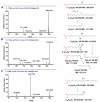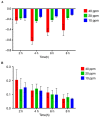Identification of Nematicidal Metabolites from Purpureocillium lavendulum
- PMID: 35889062
- PMCID: PMC9325011
- DOI: 10.3390/microorganisms10071343
Identification of Nematicidal Metabolites from Purpureocillium lavendulum
Abstract
Purpureocillium lavendulum is a fungus with promising biocontrol applications. Here, transcriptome data acquired during the infection of Caenorhabditis elegans by Purpureocillium lavendulum showed that the transcription of metabolite synthesis genes was significantly up-regulated after 24 and 48 h of the fungus-nematode interaction. Then, the up-regulated transcription level of lipoxygenase was confirmed by RT-qPCR. The ultra-performance liquid chromatography-mass spectrometry (UPLC-MS) analysis of differential metabolites revealed that this interaction resulted in the emergence of new metabolites or enhanced the production of metabolites. The results of the UPLC-MS analysis and the nematicidal assay were used to establish optimal culturing conditions under which 12 metabolites, including 3 hydroxylated C18 fatty acids and 9 steroids, were isolated and identified. Among them, hydroxylated fatty acids showed pronounced nematicidal activity against Meloidogyne incognita, and two degradative sterols showed chemotaxis activity to M. incognita. This study lays a foundation for the function of lipoxygenase and its products during the infection of Purpureocillium lavendulum.
Keywords: Meloidogyne incognita; Purpureocillium lavendulum; hydroxylated fatty acids; lipoxygenase; nematicidal activity; transcriptome data.
Conflict of interest statement
The authors declare that the research was conducted in the absence of any commercial or financial relationships that could be construed as a potential conflict of interest.
Figures








Similar articles
-
Pathogenicity and Metabolites of Purpureocillium lavendulum YMF1.00683 against Meloidogyne incognita.Pathogens. 2022 Jul 14;11(7):795. doi: 10.3390/pathogens11070795. Pathogens. 2022. PMID: 35890039 Free PMC article.
-
Functional Characterization of Core Regulatory Genes Involved in Sporulation of the Nematophagous Fungus Purpureocillium lavendulum.mSphere. 2020 Oct 28;5(5):e00932-20. doi: 10.1128/mSphere.00932-20. mSphere. 2020. PMID: 33115838 Free PMC article.
-
Ethanol mediates the interaction between Caenorhabditis elegans and the nematophagous fungus Purpureocillium lavendulum.Microbiol Spectr. 2023 Aug 10;11(5):e0127023. doi: 10.1128/spectrum.01270-23. Online ahead of print. Microbiol Spectr. 2023. PMID: 37560934 Free PMC article.
-
Eco-friendly management of Meloidogyne incognita in cadmium-contaminated soil by using nematophagous fungus Purpureocillium lavendulum YMF1.683: Efficacy and mechanism.Environ Res. 2024 Mar 1;244:117930. doi: 10.1016/j.envres.2023.117930. Epub 2023 Dec 15. Environ Res. 2024. PMID: 38103771
-
Characterization of regulatory genes Plhffp and Plpif1 involved in conidiation regulation in Purpureocillium lavendulum.Front Microbiol. 2024 Feb 15;15:1352989. doi: 10.3389/fmicb.2024.1352989. eCollection 2024. Front Microbiol. 2024. PMID: 38435693 Free PMC article.
Cited by
-
Activities and metabolomics of Cordyceps gunnii under different culture conditions.Front Microbiol. 2023 Jan 12;13:1076577. doi: 10.3389/fmicb.2022.1076577. eCollection 2022. Front Microbiol. 2023. PMID: 36713217 Free PMC article.
-
UHPLC-QTOF-MS/MS profiling, molecular networking, and molecular docking analysis of Gliricidia sepium (Jacq.) Kunth. ex. Walp. stem ethanolic extract and its gastroprotective effect on gastritis in rats.Toxicol Rep. 2025 Feb 4;14:101944. doi: 10.1016/j.toxrep.2025.101944. eCollection 2025 Jun. Toxicol Rep. 2025. PMID: 39996039 Free PMC article.
-
The Fight against Plant-Parasitic Nematodes: Current Status of Bacterial and Fungal Biocontrol Agents.Pathogens. 2022 Oct 13;11(10):1178. doi: 10.3390/pathogens11101178. Pathogens. 2022. PMID: 36297235 Free PMC article. Review.
-
Secondary metabolites and their bioactivities from Paecilomyces gunnii YMF1.00003.Front Microbiol. 2024 Feb 19;15:1347601. doi: 10.3389/fmicb.2024.1347601. eCollection 2024. Front Microbiol. 2024. PMID: 38444802 Free PMC article.
-
Volatile Metabolites from Brevundimonas diminuta and Nematicidal Esters Inhibit Meloidogyne javanica.Microorganisms. 2023 Apr 7;11(4):966. doi: 10.3390/microorganisms11040966. Microorganisms. 2023. PMID: 37110389 Free PMC article.
References
-
- Huang W.K., Sun J.H., Cui J.K., Wang G.F., Kong L.A., Peng H., Chen S.L., Peng D.L. Efficacy evaluation of fungus Syncephalastrum racemosum and nematicide avermectin against the root-knot nematode Meloidogyne incognita on cucumber. PLoS ONE. 2014;9:e89717. doi: 10.1371/journal.pone.0089717. - DOI - PMC - PubMed
-
- Castillo Lopez D., Zhu-Salzman K., Ek-Ramos M.J., Sword G.A. The entomopathogenic fungal endophytes Purpureocillium lilacinum (Formerly Paecilomyces lilacinus) and Beauveria bassiana negatively affect cotton aphid reproduction under both greenhouse and field conditions. PLoS ONE. 2014;9:e103891. doi: 10.1371/journal.pone.0103891. - DOI - PMC - PubMed
Grants and funding
LinkOut - more resources
Full Text Sources

